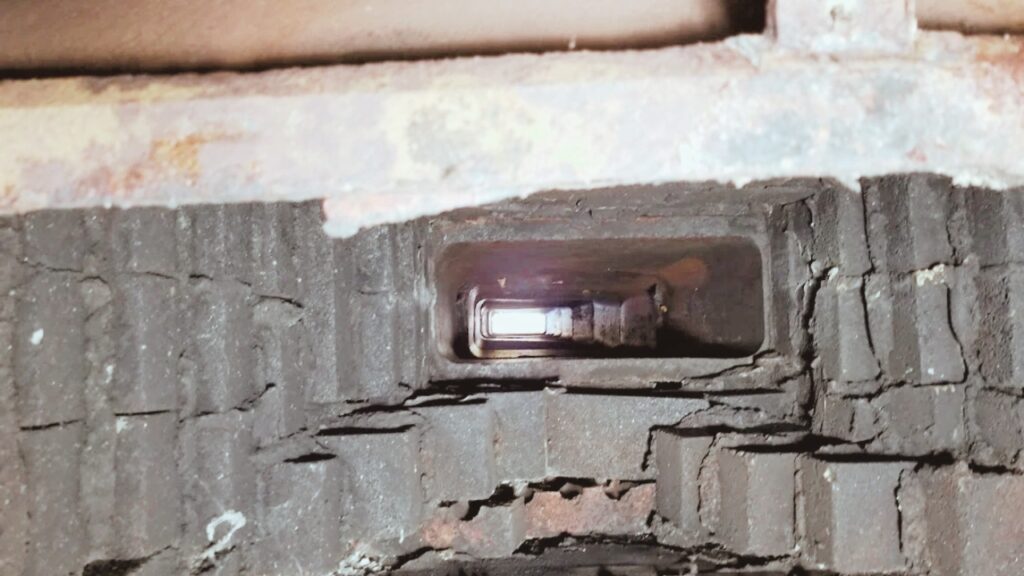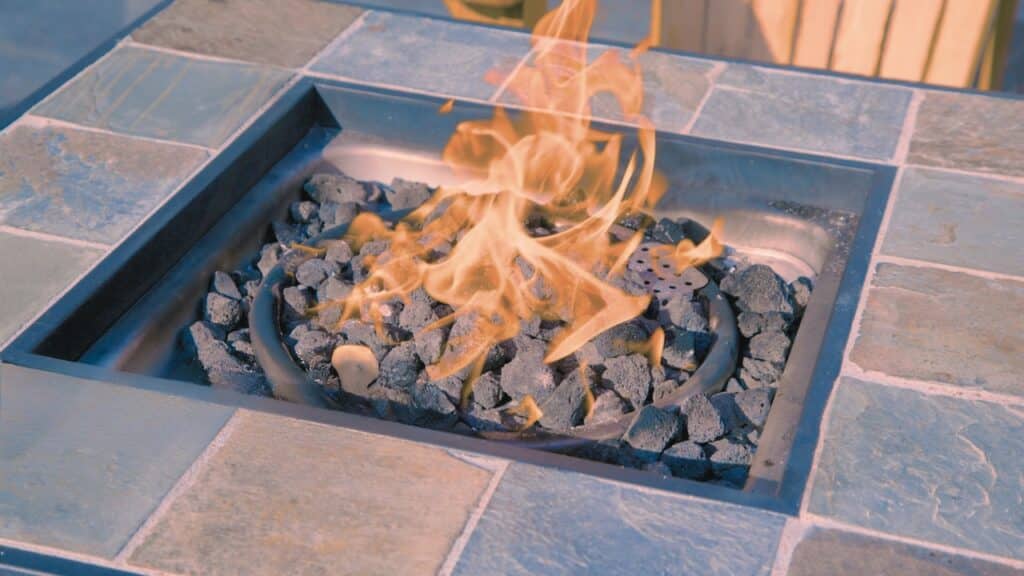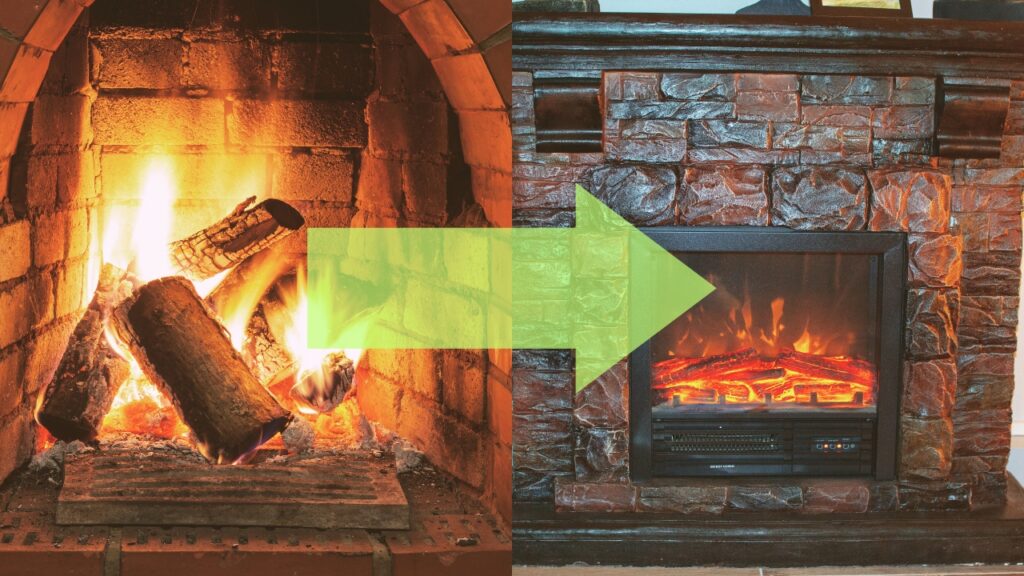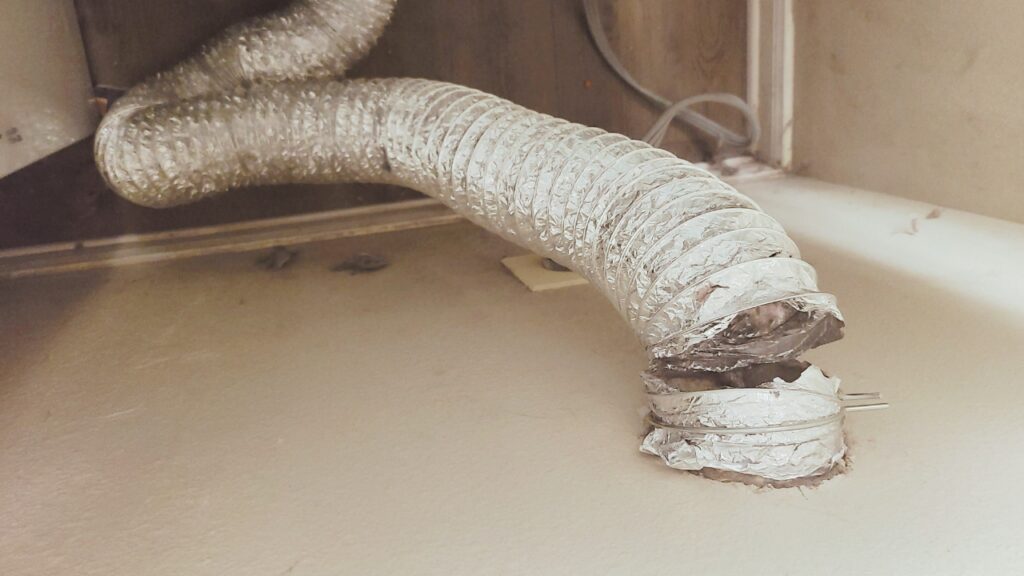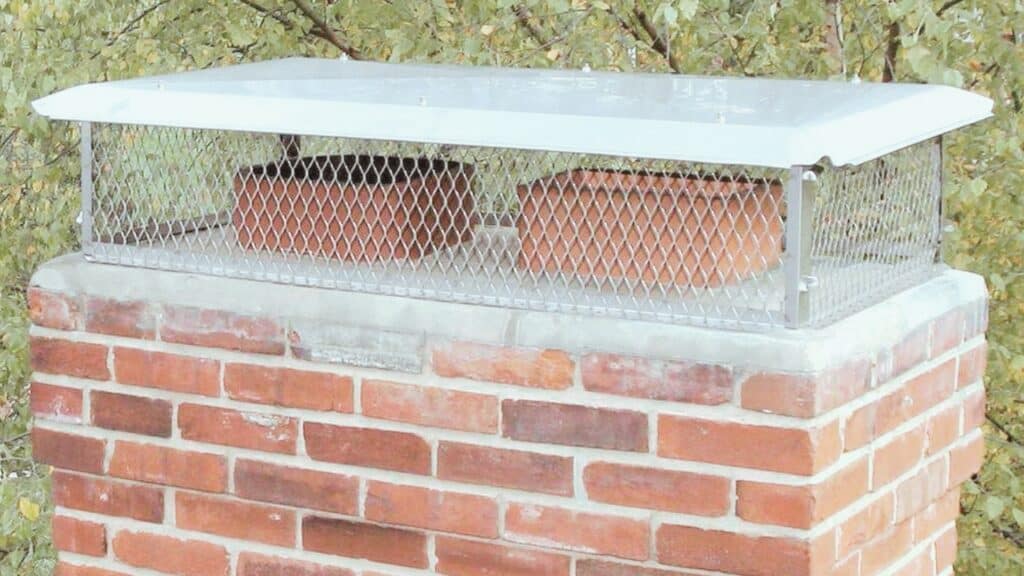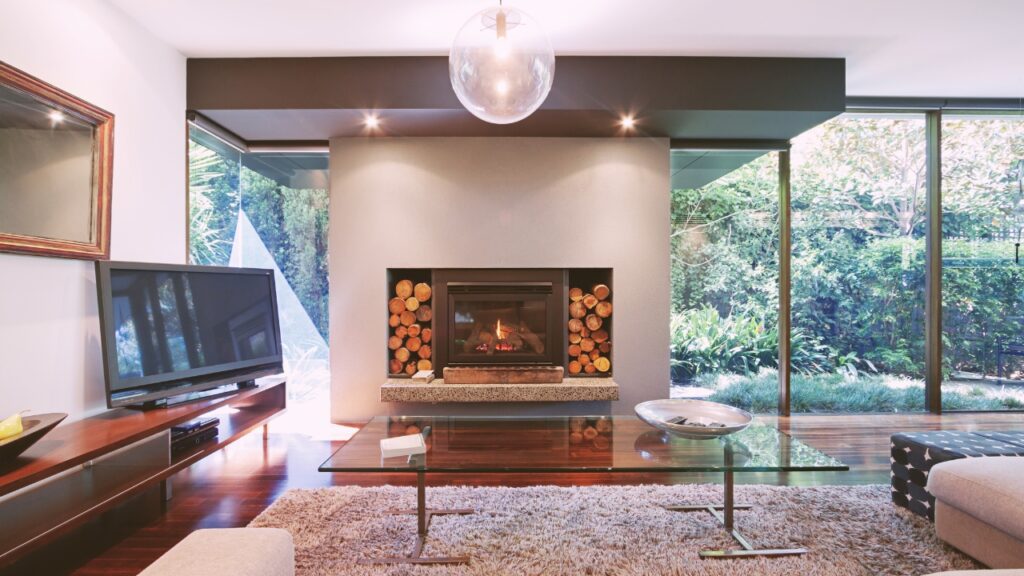There’s something undeniably mesmerizing about the warm glow of a wood-burning fireplace. A sense of tranquility and coziness envelops you as you sit by the fire, gazing through the fire grate at the crackling flames.
It’s no wonder why wood-burning fireplaces are so popular. In fact, the U.S. Energy Information Administration reported that approximately 11 million households, which accounts for 8.9% of all households in the U.S., utilized wood for energy in 2020, primarily for space heating purposes. Specifically, around 2.2 million households used wood as their primary space heating fuel.
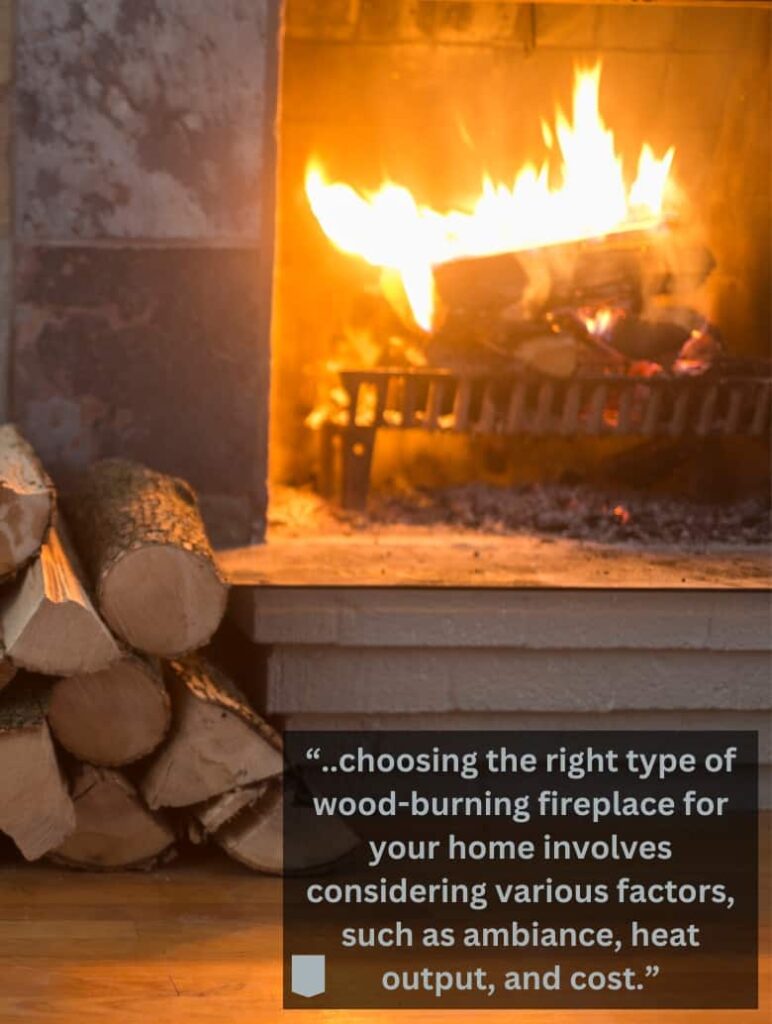
However, choosing the right type of wood-burning fireplace for your home involves considering various factors, such as ambiance, heat output, and cost.
What Are the Different Types of Wood Burning Fireplaces?
As mentioned earlier, numerous types of wood burning fireplaces are available on the market. Some of the most common include the following.
1. Traditional Open Hearth Fireplaces
Traditional open hearth fireplaces are the classic wood burning fireplaces that most people envision when they think of a cozy, crackling fire. These fireplaces typically consist of brick or stone surrounded by an open front where the fire burns.
Design and Fireplace Material
Traditional open hearth fireplaces are known for their intricate mantels, decorative hearths and can be customized to match various architectural styles. The fireplace material is usually made of fire-resistant bricks or stones, which help to retain heat and provide a durable structure.
Energy Efficiency and Heat Output
While open hearth fireplaces offer a charming ambiance, more energy-efficient options exist. The efficiency of traditional open hearth fireplaces typically ranges from 5% to 15%. Regarding heat output, these fireplaces can produce around 20,000 to 40,000 BTUs per hour.
Installation and Maintenance
Installing a traditional open hearth fireplace involves constructing a masonry chimney, which involves skilled craftsmanship. Maintenance-wise, regular chimney cleaning is necessary to remove soot and debris that can accumulate over time.
Additionally, ash removal and periodic chimney inspection are essential for safe and efficient operation.
Safety and Regulation
Some safety tips for this fireplace include using a screen or glass doors to prevent sparks from escaping, keeping flammable objects at a safe distance, and ensuring proper ventilation.
Common regulations for wood burning fireplaces may vary by location, but they often involve restrictions on emissions, installation requirements, and the use of certified stoves or inserts.
Environmental Impact
The inefficient burning of wood in these fireplaces releases more smoke and harmful gases into the atmosphere than newer, more efficient models. As a result, they may not be the most environmentally friendly choice.
——
Do You Need to Hire Chimney & Fireplace Expert?
Get free quotes from qualified experts near you. No commitment required!
——
Cost Evaluation
A traditional open hearth fireplace includes initial installation expenses and ongoing fuel costs.
- Breakdown of Initial Costs: On average, installing a traditional open hearth fireplace can range from $6,000 to $12,000, depending on size and style.
- Fuel Costs: The fuel for open hearth fireplaces is typically wood, which can be relatively affordable. However, the cost of wood can vary depending on location and availability.
Pros
- Classic and timeless design
- Authentic crackling fire experience
- A cozy and warm ambiance
Cons
- Low energy efficiency
- Limited heat output
- Potential environmental impact
- Requires regular maintenance and cleaning
- Higher installation costs
2. Closed Hearth Fireplaces
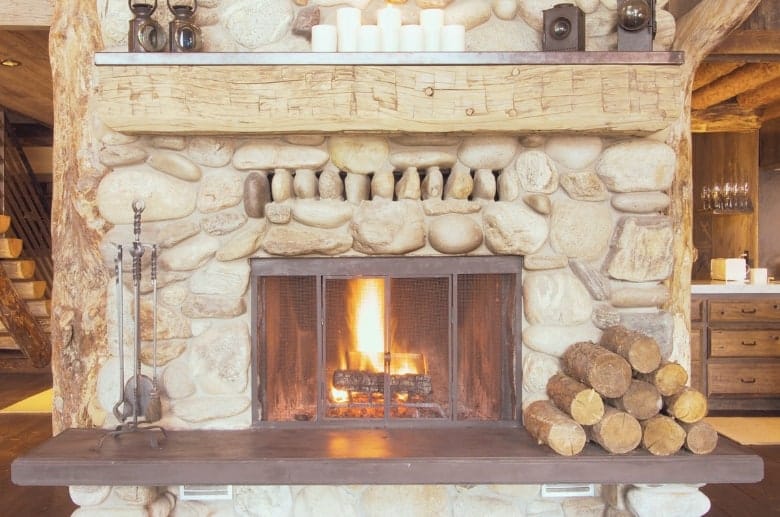
Closed hearth fireplaces feature a firebox enclosed by a glass door or metal screen, which traps the heat inside and prevents sparks and embers from escaping.
The design of the fireplace enables efficient fuel use and controlled combustion. Moreover, including a glass door or screen provides a clear and improved view of the fire, making the fireplace more visually appealing.
These fireplaces are typically constructed using heat-resistant materials such as cast iron or steel for the firebox and frame.
Energy Efficiency and Heat Output
On average, closed hearth fireplaces have an efficiency rating ranging from 70% to 85%, meaning they convert a significant portion of the wood’s energy into usable heat.
The heat output of closed hearth fireplaces varies depending on several factors but can provide a heat output of 25,000 to 80,000 BTUs per hour. However, it’s important to note that the actual heat output may differ based on the specific model and installation.
Installation and Maintenance
Installing a closed hearth fireplace often requires professional installation to ensure proper ventilation, chimney connections, and compliance with local building codes.
The installation typically involves creating a suitable chimney system or connecting it to an existing chimney, along with proper insulation and hearth construction. Maintenance for closed hearth fireplaces involves regular cleaning of the firebox, chimney sweeping, and inspection to remove any creosote buildup or debris.
Safety and Regulation
Following a few key tips when using a closed hearth fireplace is important to ensure safe operation.
- Always use a sturdy fireplace screen or glass door to prevent sparks and embers from escaping.
- Keep flammable materials at least 3 feet from the fireplace and use a proper ash container for disposing of ashes.
The regulations and codes that govern the installation and use of wood burning fireplaces may vary depending on location, so it’s crucial to check with local authorities or consult a professional to ensure compliance.
Environmental Impact
Wood-burning fireplaces, including closed hearth models, emit particulate matter and other atmospheric pollutants. Therefore, opt for properly seasoned firewood to minimize pollution, burn fires at the right temperature and adhere to local restrictions or guidelines.
Cost Evaluation
The initial cost includes the fireplace unit, installation expenses, and necessary chimney modifications. The price range for closed hearth fireplaces varies widely depending on the design, materials, and additional features.
The fuel for closed hearth fireplaces is typically wood, which can be relatively affordable compared to other fuel sources. However, the cost of wood can vary depending on location, type of wood, and availability.
Pros
- Higher energy efficiency
- Improved heat output and distribution
- Enhanced safety with the use of glass doors or screens
- Aesthetic appeal and a clear view of the fire
Cons
- Higher installation complexity and costs
- Regular maintenance requirements
- Environmental impact due to emissions
- Reliance on a constant supply of wood and potential fuel costs
3. Wood-Burning Stoves
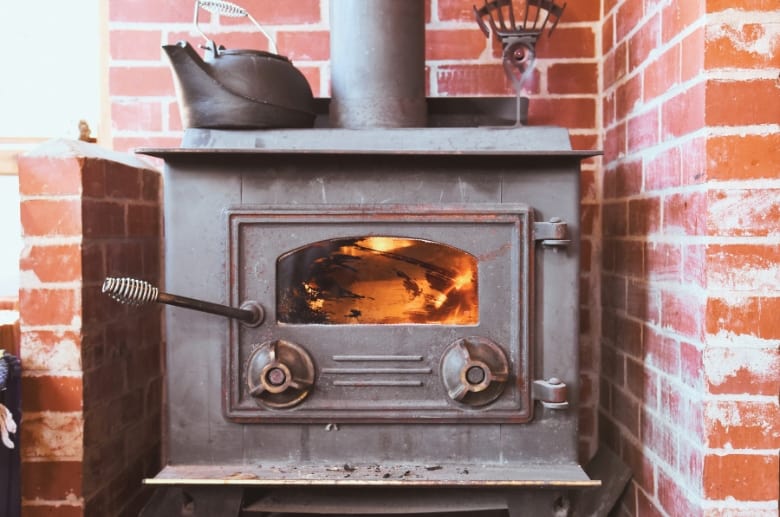
Wood-burning stoves feature a sealed combustion chamber, heat exchanger, air intake, and exhaust vents. The stove design ensures efficient fuel combustion and improved heat output compared to fireplaces.
Moreover, the types of wood-burning stoves are typically made of either cast iron or steel. Cast iron stoves are known for their durability and heat retention properties, while steel stoves are often lighter and more affordable.
Energy Efficiency and Heat Output
The energy efficiency of wood-burning stoves can range from 60% to 80% or higher, depending on the stove model. Additionally, the heat output of a wood-burning stove can range from 20,000 to 80,000 BTUs or more, depending on the size and design of the stove.
Installation and Maintenance
Installing a wood-burning stove can vary in complexity depending on location, existing chimney, and ventilation requirements. We recommended hiring a professional for proper installation.
Maintenance includes regular stove cleaning, chimney inspections, and occasional repairs or replacement of parts such as gaskets and fire bricks.
Safety and Regulation
To operate a wood-burning stove safely, use properly seasoned firewood (20% moisture content or less), avoid smoke drafts, and use the stove at safe temperatures.
Additionally, some codes and regulations govern the installation of wood burning, maintaining adequate clearance around the stove, using a stovepipe thermometer to monitor flue temperatures, and having a working carbon monoxide detector.
Environmental Impact
Wood-burning stoves release harmful particles and pollutants into the air, which can add to the problem of air pollution.
However, modern wood-burning stoves are designed to be more efficient and produce fewer emissions than older models. Using properly seasoned firewood and following best practices for combustion can further reduce the environmental impact.
Cost Evaluation
The average installation cost of a wood-burning stove can cost between $1,500 and $3,000 or even more, depending on the project’s complexity. The final cost depends on the brand, model, and features. Initial costs typically include the purchase of the stove, installation materials, and professional installation if required.
As for ongoing costs, they include the cost of wood and other fuel sources and regular maintenance such as chimney inspections.
Pros
- Efficient heating and ambiance
- Cost-effective, especially if the wood is readily available
- Wide range of styles and designs
- Works during power outages, ensuring heat source availability
Cons
- Requires a constant supply of firewood
- Regular maintenance and cleaning are necessary
- Emissions and air pollution concerns
4. Wood-Burning Fireplace Inserts
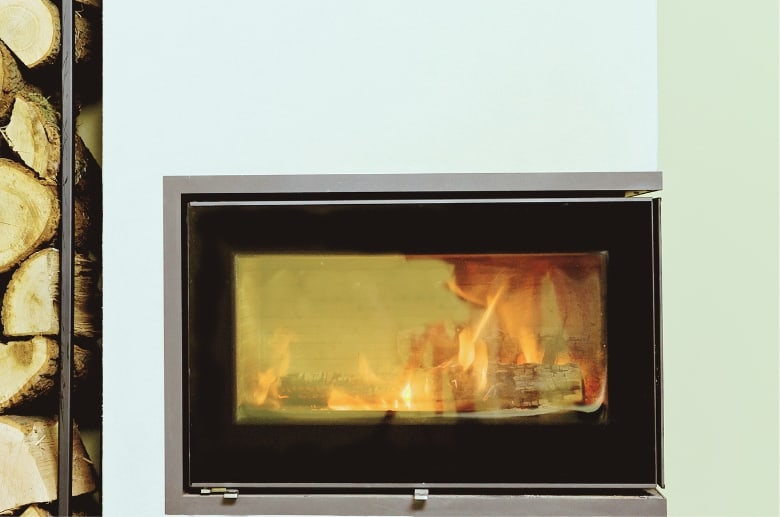
Wood-burning fireplace inserts are designed to fit into the firebox of an existing masonry or prefabricated fireplace, enhancing their performance and improving energy efficiency.
These fireplace inserts are typically made from cast iron or steel. Cast iron inserts offer durability and heat retention, while steel inserts are known for their strength and sleek design.
Energy Efficiency and Heat Output
On average, wood-burning fireplace inserts have an efficiency rating ranging from 65% to 80%. The heat output can vary depending on the model and size of the insert, typically ranging from 30,000 to 80,000 BTUs.
Installation and Maintenance
Installing a wood-burning fireplace insert usually requires professional help, as it involves fitting the insert into the existing fireplace opening and ensuring proper ventilation.
Regular maintenance, including chimney cleaning and ash removal, is necessary to ensure safe and efficient operation.
Safety and Regulation
Some safety tips for this fireplace type include using only dry and seasoned wood, regularly inspecting the chimney and flue, and installing carbon monoxide detectors.
Additionally, being aware of local regulations and codes regarding installing and operating wood-burning appliances is crucial.
Environmental Impact
When properly used with dry and seasoned wood, they can produce less smoke and particulate emissions. However, following sustainable practices such as using certified wood and ensuring efficient combustion to minimize environmental impact is essential.
Cost Evaluation
The average installation cost of a wood-burning fireplace insert can range from $700–$6,500, or more, depending on the model and complexity of installation. Additional costs may include chimney cleaning, inspection services, and replacement components such as fire bricks.
On top of installation costs, you must factor in the cost of fuel sources such as wood and charcoal.
——
Do You Need to Hire Chimney & Fireplace Expert?
Get free quotes from qualified experts near you. No commitment required!
——
Pros
- Improved energy efficiency and heat output
- Ability to convert an existing fireplace into a more efficient heating source
- Aesthetically pleasing design options
- Reduced environmental impact when used properly
Cons
- Professional installation is usually required
- Regular maintenance is necessary
- Costs can be higher compared to other heating options
- Reliance on a steady supply of firewood
5. Masonry Heaters
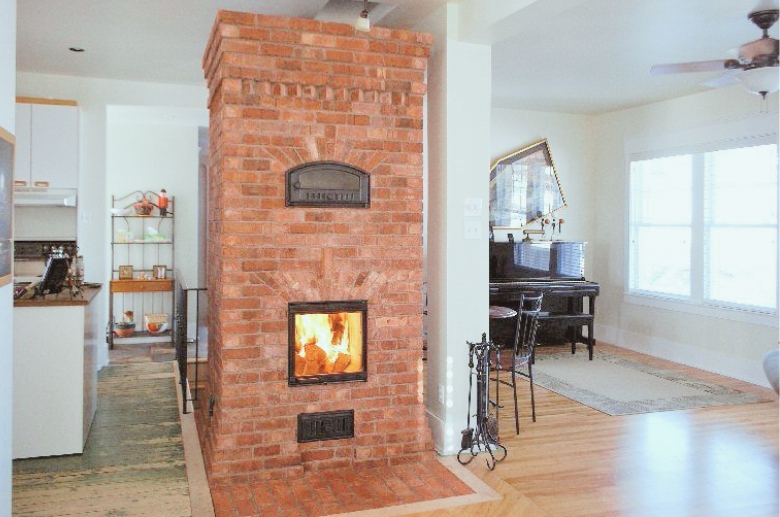
Masonry heaters are constructed using solid masonry materials such as brick, stone, or tile, designed to absorb and radiate heat for an extended period.
Moreover, these heaters are built with a large, intricate structure that consists of a firebox, channels, and a heat exchange system. The firebox is where the wood is burned, and the channels allow the hot gases to circulate and release heat into the surrounding masonry.
Energy Efficiency and Heat Output
Masonry heaters are highly efficient and achieve 90% or more efficiency levels. The heat output of a masonry heater can vary depending on its size and design, but it typically ranges from 20,000 to 60,000 BTUs per hour.
Installation and Maintenance
Installing a masonry heater requires professional expertise and involves careful planning, design, and skilled masonry work.
Regular maintenance involves inspecting and cleaning the chimney and checking the firebox, channels, and heat exchange system for any signs of damage or buildup. The specific maintenance requirements may vary depending on the design and materials used.
Safety and Regulation
The safety guidelines for this type of fireplace include using proper fireplace tools, maintaining clearances around the heater, and ensuring adequate ventilation.
Additionally, it’s essential to comply with local building codes and regulations regarding installing and using wood-burning appliances.
Environmental Impact
Masonry heaters are known for their environmental friendliness. Due to their high efficiency, they burn wood more cleanly and produce fewer emissions than traditional open fireplaces or older wood stoves.
However, using properly seasoned firewood and practicing responsible wood burning is still important to minimize environmental impact.
Cost Evaluation
Installing a masonry heater can be quite expensive, with estimated installation costs ranging from $5,000 to $25,000 or more. The cost of materials such as brick and tile may vary depending on the specific design and size of the heater.
You’ll also need to factor in additional costs for maintenance services such as chimney sweeping, inspection, and replacement components. Additionally, it is important to consider ongoing fuel costs, which will depend on the availability and cost of firewood in your area.
Pros
- Exceptional energy efficiency
- High heat output
- Long-lasting heat retention
- Customizable designs to suit different architectural styles
- Reduced environmental impact
Cons
- Higher initial installation costs
- Requires professional expertise for installation and maintenance
- Takes time to heat up initially due to the thermal mass of the masonry
- Relatively long installation time
6. Faux Wood Fireplaces

Faux wood fireplaces, also known as gas or electric fireplaces with simulated wood-burning effects, provide the ambiance and appearance of a traditional wood-burning fireplace without actual wood fuel.
Faux wood fireplaces typically feature a realistic-looking flame pattern that mimics the appearance of burning wood. The flames are generated through either gas or electric means, and logs or inserts made from non-combustible materials, such as ceramic fiber, are used to create the illusion of burning wood.
Energy Efficiency and Heat Output
Gas fireplaces tend to be more efficient, with an efficiency rating of 70% to 99%. Similarly, electric fireplaces convert all their energy into heat, making them 100% efficient. The heat output of these fireplaces can range from around 4,000 BTUs for smaller models to over 60,000 BTUs for larger units.
Installation and Maintenance
Gas fireplaces require professional installation, as they need a gas line connection and proper venting. On the other hand, electric fireplaces are easier to install since they only require a power source.
Maintenance for faux wood fireplaces is minimal, usually involving periodic cleaning and inspection of the components, such as the gas valves or electrical connections.
Safety and Regulation
Faux wood fireplaces offer enhanced safety features compared to traditional wood-burning fireplaces. Gas fireplaces have oxygen depletion sensors and safety shut-off valves, ensuring proper ventilation and gas supply control.
Electric fireplaces eliminate the risk of sparks, embers, or creosote buildup. When operating any fireplace, following safety guidelines, such as keeping flammable materials away and using a protective screen, is important.
Environmental Impact
Gas fireplaces produce fewer emissions, such as particulate matter and carbon monoxide, than wood-burning ones. Likewise, electric fireplaces produce no emissions directly, but the source of electricity used to power them might have an impact depending on their generation method.
Cost Evaluation
The average installation cost of a faux wood fireplace varies depending on the type and complexity of the installation. Gas fireplaces, including installation, can range from $2,000 to $5,000.
Electric fireplaces are generally more affordable, with prices ranging from $500 to $2,000, including installation. Additionally, you should consider the ongoing fuel costs. Gas fireplaces require a supply of natural gas or propane, while electric fireplaces rely on electricity.
Pros
- Realistic flame effect without the need for wood fuel
- Higher energy efficiency
- Easy installation process for electric fireplaces
- Enhanced safety features
- Reduced environmental impact, especially for gas fireplaces
Cons
- Require professional installation and proper venting
- Electric fireplaces may not have the same heat level as gas or wood-burning ones
- Ongoing fuel costs for gas fireplaces
- Limited authenticity compared to a real wood-burning fireplace’s aroma and crackling sound
7. Prefab Wood Fireplaces
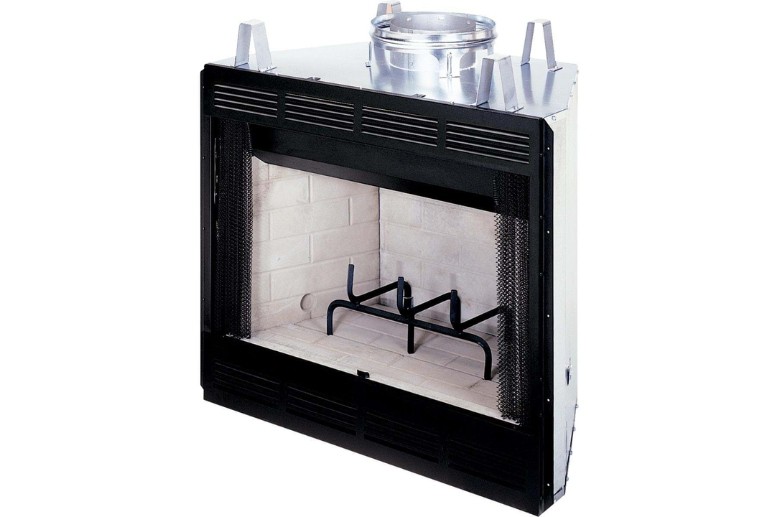
Prefab wood fireplaces, also known as factory-built or zero-clearance fireplaces, are popular for homeowners who want the warmth and ambiance of a traditional wood-burning fireplace without extensive construction.
These fireplaces are designed to be installed in a prefabricated metal or insulated firebox, which can be placed against a combustible wall or enclosed within a wooden or masonry structure.
Prefab wood fireplaces typically feature a metal firebox surrounded by a metal or insulated shell. The firebox has refractory panels that help withstand high temperatures and enhance the unit’s longevity.
To match the homeowner’s aesthetic preferences, the outer shell can be customized with various finishes, such as steel, cast iron, or ceramic tiles.
Energy Efficiency and Heat Output
The efficiency of these fireplaces can range from 50% to 80%, depending on the model. The heat output varies widely depending on the specific fireplace model but generally falls between 25,000 to 80,000 BTUs.
Installation and Maintenance
Installing a prefab wood fireplace is less complex and time-consuming than building a traditional masonry fireplace. However, it still requires proper installation by a professional to ensure safety and efficiency.
Maintenance typically involves regular cleaning of the firebox, chimney, and flue and periodic inspection and repair of the refractory panels, gaskets, and other components.
Safety and Regulation
Some tips for safe operation include using only dry and seasoned firewood, ensuring proper ventilation, and regularly inspecting and cleaning the chimney.
Additionally, it’s important to adhere to local regulations and building codes regarding installation clearances, chimney height, and emission standards.
——
Do You Need to Hire Chimney & Fireplace Expert?
Get free quotes from qualified experts near you. No commitment required!
——
Environmental Impact
Wood-burning fireplaces, including prefab wood fireplaces, produce emissions that can contribute to air pollution. To minimize environmental impact, it’s recommended to use properly seasoned firewood and follow clean-burning practices.
Some models of prefab wood fireplaces may also be certified as low-emission or EPA-approved, offering improved combustion efficiency and reduced emissions.
Cost Evaluation
The average installation cost of a prefab wood fireplace can range from $2,000 to $6,000, depending on various factors such as the complexity of the installation, additional venting requirements, and customization options.
The breakdown of initial costs includes the fireplace unit itself, chimney components, installation labor, and any necessary permits. Fuel costs for wood-burning fireplaces can vary depending on the local availability and price of firewood.
Pros
- Ease of installation
- Versatile designs and styles
- Higher energy efficiency
- Customizable finishes
- Can provide a significant heat output
ConsCons
- Limited heat control
- Regular maintenance and cleaning requirements
- Environmental impact due to emissions
- Reliance on a constant supply of firewood
- Initial installation costs can be higher
8. Clean Burning Fireplaces
Clean-burning fireplaces are designed to maximize efficiency and minimize environmental impact by burning wood more efficiently and producing fewer emissions.
These fireplaces often incorporate secondary burn chambers, catalytic converters, or air injection systems to promote complete wood combustion and reduce the release of particulate matter and harmful gases.
Clean-burning fireplace materials and styles can vary, but commonly used materials include steel, cast iron, or refractory materials.
Energy Efficiency and Heat Output
Depending on the specific model and design, these fireplaces can achieve efficiency ratings ranging from 60% to 80% or even higher.
The heat output of clean-burning fireplaces can vary widely based on the size and design of the fireplace, typically falling between 30,000 BTUs to 80,000 BTUs or more.
Installation and Maintenance
We highly recommend professional installation by a certified technician to ensure the proper functioning and safety of these fireplaces.
Maintenance needs may vary depending on the specific fireplace model. Still, clean burning fireplaces generally require regular combustion chamber cleaning, ash removal, and periodic catalytic converter inspection (if applicable).
Safety and Regulation
To operate clean burning fireplaces safely, it’s important to follow these tips:
- Always use dry, seasoned firewood.
- Keep the fireplace well-ventilated and ensure proper airflow.
- Install carbon monoxide detectors in the vicinity of the fireplace.
- Regularly inspect and clean the chimney (at least once a year).
- Follow local regulations and building codes regarding fireplace installation and operation.
It’s best to familiarize yourself with the regulations specific to your area before installing a fireplace.
Environmental Impact
By promoting complete combustion, clean-burning fireplaces produce fewer particulate matter, carbon monoxide, and other harmful gases than traditional fireplaces.
However, it’s important to note that burning wood still contributes to air pollution, albeit at lower levels. Consider the environmental impact of sourcing firewood sustainably and using it efficiently to minimize the overall carbon footprint.
Cost Evaluation
The installation costs range from $3,000 to $7,000 or more, with the breakdown of initial costs looking like this:
- Fireplace unit: $1,500 to $4,000
- Venting system: $500 to $1,500
- Installation labor: $1,000 to $2,500
The cost of firewood will depend on your location and availability, but it’s generally more affordable than fossil fuels or electricity.
Pros
- Increased energy efficiency and heat output
- Reduced emissions and environmental impact
- Wide range of design options to suit different aesthetics
- Potential cost savings on heating bills
Cons
- Higher upfront cost
- Installation may require professional assistance
- Regular maintenance is necessary to ensure optimal performance
- Wood sourcing and storage require additional effort
Evaluate your needs and preferences regarding energy efficiency, installation complexity, and cost to determine which type of fireplace best suits your home. But more importantly, ensure you seek the help of a certified professional for safe installation and operation.
What Are The Different Classifications For Wood Fireplaces?
With growing concerns about air pollution and climate change, it’s important to understand the different classifications and options available for wood fireplaces.
EPA Certified vs. Uncertified
The Environmental Protection Agency (EPA) has established certain emission standards regarding wood fireplaces to limit the pollutants released into the air. EPA-certified fireplaces meet these standards, while uncertified fireplaces do not.
The EPA standards for wood-burning fireplaces focus on reducing particulate matter, carbon monoxide, and other harmful pollutants emissions. These standards aim to improve air quality, minimize health risks, and mitigate the environmental impact of wood burning.
Moreover, wood fireplaces have two classifications: EPA-certified and decorative (EPA-exempt).
1. EPA-Certified Fireplaces
EPA-certified fireplaces are designed with advanced technology and features that help to burn wood more efficiently and produce fewer emissions. These fireplaces often include features like secondary combustion, which helps to burn off additional smoke and gases. They typically have a catalytic converter or a secondary combustion chamber that aids in reducing emissions.
2. Decorative (EPA Exempt) Fireplaces
Decorative or EPA-exempt fireplaces do not meet the EPA’s emission standards. They are primarily designed for aesthetics and may not be as efficient or environmentally friendly as EPA-certified models. While they can still provide warmth and a cozy atmosphere, they may produce higher levels of smoke and pollutants.
——
Do You Need to Hire Chimney & Fireplace Expert?
Get free quotes from qualified experts near you. No commitment required!
——
What Is The Best Fuel For a Wood-Burning Fireplace?
The best fuel for a wood-burning fireplace is seasoned hardwood, like oak or hickory. These woods burn hotter and longer due to their dense and low moisture content, providing efficient heating and a pleasant, crackling fire.
Types of Wood Fuel
Several types of wood fuel are commonly used in wood-burning fireplaces:
- Hardwood: Hardwoods such as oak, maple, ash, and birch are known for their dense composition and high energy content. They burn more slowly and produce long-lasting and consistent heat.
- Softwood: Softwoods like pine, fir, spruce, and cedar have a lower density than hardwoods. They ignite more quickly and produce a lively flame.
- Biomass Fuel: Biomass fuel includes wood pellets, chips, and agricultural residues. These fuels are typically processed and manufactured into uniform sizes for efficient combustion.
- Sawdust Bricks: Sawdust bricks are compressed blocks from sawdust and offer a convenient and clean-burning option for wood-burning fireplaces.
When considering the installation of a wood fireplace, there are several important factors to consider. These factors include the following.
Location
PlaceYou should place your wood fireplace in a central area of your home where it can effectively provide heat to the surrounding rooms. Consider the layout of your space and identify a location that allows for optimal heat distribution.
Space
Measure the area where you plan to install the fireplace to ensure it can accommodate the necessary clearances and safety requirements. Remember that wood fireplaces require a certain amount of clearance around them to reduce the risk of fire hazards.
Chimney Access
Consider whether your home already has a chimney or if you’ll need to install a new one. Chimney access is crucial for proper ventilation and safely releasing smoke and gases the fire produces.
Safety Regulations
Before proceeding with the installation, familiarize yourself with the specific regulations in your area. These regulations typically cover aspects such as clearances, ventilation requirements, and the use of appropriate materials. Adhering to these regulations will help ensure the safety of your home and its occupants.
Conclusion
Wood-burning fireplaces are an elegant and timeless way to bring warmth and ambiance to any home. Not only do these fireplaces provide a cozy atmosphere, but they also offer efficient heating options for colder climates.
Before making a decision, understand your needs, local safety regulations, and the potential costs of installation. And with professional help, you’ll be able to enjoy your wood fireplace for many years.

